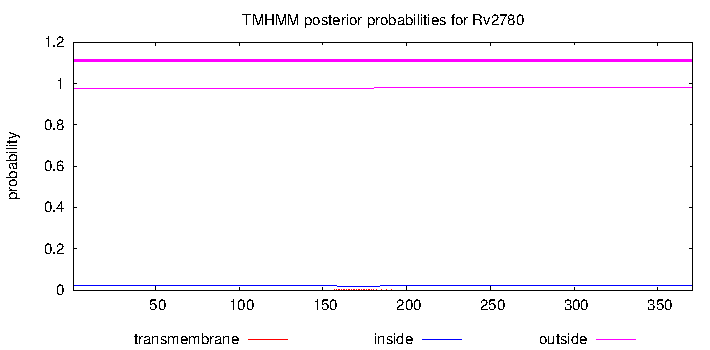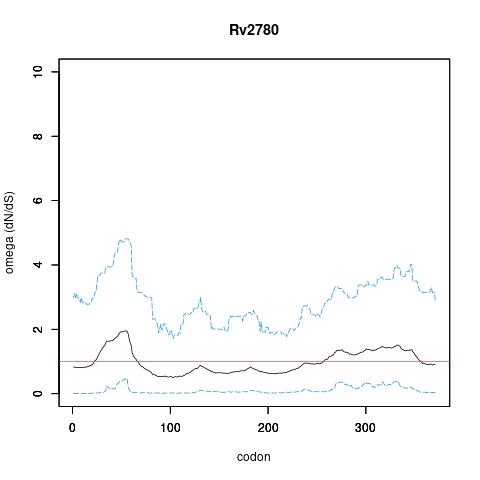Rv2780 (ald)
Current annotations:
TBCAP: (community-based annotations - see table at bottom of page )
TBDB: alanine dehydrogenase
REFSEQ: secreted L-alanine dehydrogenase ALD (40 kDa antigen) (TB43)
PATRIC: Alanine dehydrogenase (EC 1.4.1.1)
TUBERCULIST: Secreted L-alanine dehydrogenase Ald (40 kDa antigen) (TB43)
NCBI: Secreted L-alanine dehydrogenase Ald (40 kDa antigen) (TB43)
updated information (H37Rv4):
gene name: ald
function:
reference:
Type: Not Target
Start: 3086820
End: 3087935
Operon:
Trans-membrane region:
Role: I.A.2 - Amino acids and amines
GO terms:
Reaction(s) (based on iSM810 metabolic model):
Gene Expression Profile Gene Modules Orthologs among selected mycobacteria Protein structure: 2voe , 2vhw , 2vhv , 2vhz , 2vhy , 2vhx , 2voj
Search for Homologs in PDB Top 10 Homologs in PDB (as of Nov 2020): PDB aa ident species PDB title 6O7F 100% Mycobacterium tuberculosis (strain ATCC 25618 / H37Rv) Mycobacterium tuberculosis L-alanine dehydrogenase x-ray structure in complex with N6-isobutyl adenosine 4LMP 100% Mycobacterium tuberculosis Mycobacterium tuberculosis L-alanine dehydrogenase x-ray structure in complex with N6-methyl adenosine 2VOJ 100% MYCOBACTERIUM TUBERCULOSIS Ternary complex of M. tuberculosis Rv2780 with NAD and pyruvate 2VOE 100% MYCOBACTERIUM TUBERCULOSIS Crystal structure of Rv2780 from M. tuberculosis H37Rv 2VHZ 100% MYCOBACTERIUM TUBERCULOSIS Crystal structure of holo L-alanine dehydrogenase from Mycobacterium tuberculosis in the closed conformation 2VHY 100% MYCOBACTERIUM TUBERCULOSIS Crystal structure of apo L-alanine dehydrogenase from Mycobacterium tuberculosis 2VHX 100% MYCOBACTERIUM TUBERCULOSIS Crystal structure of the ternary complex of L-alanine dehydrogenase from Mycobacterium tuberculosis with NAD+ and pyruvate 2VHW 100% MYCOBACTERIUM TUBERCULOSIS Crystal structure of holo L-alanine dehydrogenase from Mycobacterium tuberculosis in the open and closed conformation 2VHV 99% MYCOBACTERIUM TUBERCULOSIS Crystal structure of the D270A mutant of L-alanine dehydrogenase from Mycobacterium tuberculosis in complex with NADH. 2EEZ 56% Thermus thermophilus Crystal structure of alanine dehydrogenase from themus thermophilus
Links to additional information on ald:
Amino Acid Sequence
MRVGIPTETKNNEFRVAITPAGVAELTRRGHEVLIQAGAGEGSAITDADFKAAGAQLVGTADQVWADADLLLKVKEPIAAEYGRLRHGQILFTFLHLAAS
RACTDALLDSGTTSIAYETVQTADGALPLLAPMSEVAGRLAAQVGAYHLMRTQGGRGVLMGGVPGVEPADVVVIGAGTAGYNAARIANGMGATVTVLDIN
IDKLRQLDAEFCGRIHTRYSSAYELEGAVKRADLVIGAVLVPGAKAPKLVSNSLVAHMKPGAVLVDIAIDQGGCFEGSRPTTYDHPTFAVHDTLFYCVAN
MPASVPKTSTYALTNATMPYVLELADHGWRAACRSNPALAKGLSTHEGALLSERVATDLGVPFTEPASVLA
(
Nucleotide sequence available on
KEGG )
Additional Information
Analysis of Positive Selection in Clinical Isolates
*new*
Analysis of dN/dS (omega) in two collections of Mtb clinical isolates using GenomegaMap (Window model) (see description of methods )
Moldova: 2,057 clinical isolates
global set: 5,195 clinical isolates from 15 other countries
In the omega plots, the black line shows the mean estimate of omega (dN/dS) at each codon, and the blue lines are the bounds for the 95% credible interval (95%CI, from MCMC sampling).
A gene is under significant positive selection if the lower-bound of the 95%CI of omega (lower blue line) exceeds 1.0 at any codon.
Moldova (2,057) global set (5,195)
under significant positive selection? NO NO
omega peak height (95%CI lower bound) 1.95 (0.49) 1.45 (0.76)
codons under selection
omega plots
genetic variants* link link
statistics at each codon link link
* example format for variants: "D27 (GAC): D27H (CAC,11)" means "Asp27 (native codon GAC) mutated to His (codon CAC) in 11 isolates"
MtbTnDB - interactive tool for exploring a database of published TnSeq datasets for Mtb
TnSeqCorr
Rv2780/ald,
gene len: 1115 bp, num TA sites: 25
condition dataset call medium method notes
in-vitro DeJesus 2017 mBio non-essential 7H9 HMM fully saturated, 14 TnSeq libraries combined
in-vitro Sassetti 2003 Mol Micro non-essential 7H9 TRASH essential if hybridization ratio<0.2
in-vivo (mice) Sassetti 2003 PNAS non-essential BL6 mice TRASH essential if hybridization ratio<0.4, min over 4 timepoints (1-8 weeks)
in-vitro (glycerol) Griffin 2011 PPath non-essential M9 minimal+glycerol Gumbel 2 replicates; Padj<0.05
in-vitro (cholesterol) Griffin 2011 PPath non-essential M9 minimal+cholesterol Gumbel 3 replicates; Padj<0.05
differentially essential in cholesterol Griffin 2011 PPath NO (LFC=0.19) cholesterol vs glycerol resampling-SR YES if Padj<0.05, else not significant; LFC<0 means less insertions/more essential in cholesterol
in-vitro Smith 2022 eLife non-essential 7H9 HMM 6 replicates (raw data in Subramaniam 2017, PMID 31752678)
in-vivo (mice) Smith 2022 eLife non-essential BL6 mice HMM 6 replicates (raw data in Subramaniam 2017, PMID 31752678)
differentially essential in mice Smith 2022 eLife NO (LFC=0.317) in-vivo vs in-vitro ZINB YES if Padj<0.05, else not significant; LFC<0 means less insertions/more essential in mice
in-vitro (minimal) Minato 2019 mSys non-essential minimal medium HMM
in-vitro (YM rich medium) Minato 2019 mSys non-essential YM rich medium HMM 7H9 supplemented with ~20 metabolites (amino acids, cofactors)
differentially essential in YM rich medium Minato 2019 mSys NO (LFC=0.53) YM rich vs minimal medium resampling
TnSeq Data No data currently available.
No TnSeq data currently available for this Target.
RNASeq Data No data currently available.
No RNA-Seq data currently available for this Target.
Metabolomic Profiles No data currently available.
No Metabolomic data currently available for this Target.
Proteomic Data No data currently available.
No Proteomic data currently available for this Target.
Regulatory Relationships from Systems Biology
BioCyc
Gene interactions based on ChIPSeq and Transcription Factor Over-Expression (TFOE) (Systems Biology )
NOTE:
Green edges represent the connected genes being classified as differentially essential as a result of the middle gene being knocked out. These interactions are inferred based on RNASeq.
Interactions based on ChIPSeq data
RNA processing and modification
Energy production and conversion
Chromatin structure and dynamics
Amino acid transport and metabolism
Cell cycle control, cell division, chromosome partitioning
Carbohydrate transport and metabolism
Nucleotide transport and metabolism
Lipid transport and metabolism
Coenzyme transport and metabolism
Translation, ribosomal structure and biogenesis
Cell wall/membrane/envelope biogenesis
Replication, recombination and repair
Posttranslational modification, protein turnover, chaperones
Secondary metabolites biosynthesis, transport and catabolism
Inorganic ion transport and metabolism
General function prediction only
Intracellular trafficking, secretion, and vesicular transport
Signal transduction mechanisms
Differentially expressed as result of RNASeq in glycerol environment (Only top 20 genes shown sorted by log fold change with p_adj 0.05).
Conditionally essential as result of TNSeq (Only top 20 genes shown sorted by log fold change with p_adj 0.05).
Binds To:
No bindings to other targets were found.
Bound By:
No bindings from other targets were found.
Binds To:
No bindings to other targets were found.
Bound By:
Upregulates:
Does not upregulate other genes.
Upregulated by:
Not upregulated by other genes.
Downregulates:
Does not downregulate other genes.
Downregulated by:
Not downregulated by other genes.
Property Value Creator Evidence PMID Comment
Interaction Regulatory Rv2779c sumaavasthi ISO Operon (Functional linkage)authors,Z. Feng,NE. Cceres,G. Sarath,RG. Barletta Mycobacterium smegmatis L-alanine dehydrogenase (Ald) is required for proficient utilization of alanine as a sole nitrogen source and sustained anaerobic growth. J. Bacteriol. 2002
Interaction Regulatory Rv0757 singhpankaj2116 IEP Co-expression (Functional linkage)ML. Chesne-Seck, N. Barilone et al. A point mutation in the two-component regulator PhoP-PhoR accounts for the absence of polyketide-derived acyltrehaloses but not that of phthiocerol dimycocerosates in Mycobacterium tuberculosis H37Ra. J. Bacteriol. 2008
Interaction Regulatory Rv0757 singhpankaj2116 IEP Co-expression (Functional linkage)authors,A. Sola-Landa,RS. Moura,JF. Martn The two-component PhoR-PhoP system controls both primary metabolism and secondary metabolite biosynthesis in Streptomyces lividans. Proc. Natl. Acad. Sci. U.S.A. 2003
Interaction Regulatory Rv0757 singhpankaj2116 IEP Co-expression (Functional linkage)J. Gonzalo Asensio, C. Maia et al. The virulence-associated two-component PhoP-PhoR system controls the biosynthesis of polyketide-derived lipids in Mycobacterium tuberculosis. J. Biol. Chem. 2006
Interaction Regulatory Rv0757 singhpankaj2116 IEP Co-expression (Functional linkage)J. Gonzalo-Asensio, CY. Soto et al. The Mycobacterium tuberculosis phoPR operon is positively autoregulated in the virulent strain H37Rv. J. Bacteriol. 2008
Interaction Regulatory Rv0757 singhpankaj2116 IEP Co-expression (Functional linkage)A. Sinha, S. Gupta et al. PhoP-PhoP interaction at adjacent PhoP binding sites is influenced by protein phosphorylation. J. Bacteriol. 2008
Interaction Regulatory Rv0757 singhpankaj2116 IEP Co-expression (Functional linkage)J. Gonzalo Asensio, C. Maia et al. The virulence-associated two-component PhoP-PhoR system controls the biosynthesis of polyketide-derived lipids in Mycobacterium tuberculosis. J. Biol. Chem. 2006
Interaction Regulatory Rv0757 singhpankaj2116 IEP Co-expression (Functional linkage)M. Ryndak, S. Wang et al. PhoP, a key player in Mycobacterium tuberculosis virulence. Trends Microbiol. 2008
Interaction Regulatory Rv0757 singhpankaj2116 IEP Co-expression (Functional linkage)JA. Asensio, A. Arbus et al. Live tuberculosis vaccines based on phoP mutants: a step towards clinical trials. Expert opinion on biological therapy 2008
Interaction Regulatory Rv0757 singhpankaj2116 IEP Co-expression (Functional linkage)SB. Walters, E. Dubnau et al. The Mycobacterium tuberculosis PhoPR two-component system regulates genes essential for virulence and complex lipid biosynthesis. Mol. Microbiol. 2006
Interaction Regulatory Rv0757 singhpankaj2116 IEP Co-expression (Functional linkage)J. Gonzalo-Asensio, S. Mostowy et al. PhoP: a missing piece in the intricate puzzle of Mycobacterium tuberculosis virulence. PLoS ONE 2008
Interaction RegulatedBy Rv0348 yamir.moreno IEP Microarrays. mRNA levels of regulated element measured and compared between wild-type and trans-element mutation (knockout, over expression etc.) performed by using microarray (or macroarray) experiments..B. Abomoelak, EA. Hoye et al. mosR, a novel transcriptional regulator of hypoxia and virulence in Mycobacterium tuberculosis. J. Bacteriol. 2009
Interaction RegulatedBy Rv0757 yamir.moreno IEP Microarrays. mRNA levels of regulated element measured and compared between wild-type and trans-element mutation (knockout, over expression etc.) performed by using microarray (or macroarray) experiments..J. Gonzalo Asensio, C. Maia et al. The virulence-associated two-component PhoP-PhoR system controls the biosynthesis of polyketide-derived lipids in Mycobacterium tuberculosis. J. Biol. Chem. 2006
Interaction RegulatedBy Rv0491 yamir.moreno IEP Microarrays. mRNA levels of regulated element measured and compared between wild-type and trans-element mutation (knockout, over expression etc.) performed by using microarray (or macroarray) experiments..T. Parish, DA. Smith et al. The senX3-regX3 two-component regulatory system of Mycobacterium tuberculosis is required for virulence. Microbiology (Reading, Engl.) 2003
Citation Glutamate synthesis in Streptomyces coelicolor. authors,SH. Fisher J. Bacteriol. 1989 jjmcfadden 2708309 Inferred from direct assay
Term EC:1.4.1.1 Alanine dehydrogenase. - NR jjmcfadden NR Inferred from direct assayauthors,SH. Fisher Glutamate synthesis in Streptomyces coelicolor. J. Bacteriol. 1989
Citation Glycine and alanine dehydrogenase activities are catalyzed by the same protein in Mycobacterium smegmatis: upregulation of both activities under microaerophilic adaptation. authors,V. Usha,R. Jayaraman,JC. Toro,SE. Hoffner,KS. Das Can. J. Microbiol. 2002 extern:JZUCKER 11888165 Assay of protein purified to homogeneity
Term EC:1.4.1.10 Glycine dehydrogenase. - NR extern:JZUCKER NR Assay of protein purified to homogeneityauthors,V. Usha,R. Jayaraman,JC. Toro,SE. Hoffner,KS. Das Glycine and alanine dehydrogenase activities are catalyzed by the same protein in Mycobacterium smegmatis: upregulation of both activities under microaerophilic adaptation. Can. J. Microbiol. 2002
Term EC:1.4.1.1 Alanine dehydrogenase. - NR extern:JZUCKER NR Assay of protein purified to homogeneityauthors,V. Usha,R. Jayaraman,JC. Toro,SE. Hoffner,KS. Das Glycine and alanine dehydrogenase activities are catalyzed by the same protein in Mycobacterium smegmatis: upregulation of both activities under microaerophilic adaptation. Can. J. Microbiol. 2002
Term EC:1.5.1.7 Saccharopine dehydrogenase (NAD(+), L-lysine-forming). - NR extern:JZUCKER NR Assay of protein purified to homogeneityauthors,V. Usha,R. Jayaraman,JC. Toro,SE. Hoffner,KS. Das Glycine and alanine dehydrogenase activities are catalyzed by the same protein in Mycobacterium smegmatis: upregulation of both activities under microaerophilic adaptation. Can. J. Microbiol. 2002


